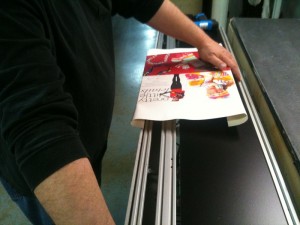Friday, April 7, 2017
Oil-less Pneumatic Cylinders
Dual-Purpose Stretcher Bar
Dual Purpose Stretcher Bar
New Life for Custom Frame Shops – Stretching Large Canvas
New Life for Custom Frame Shops – Stretching Large Canvas
Comments are closed.
4 Canvas Stretching Techniques That Will Increase Your Productivity
4 Canvas Stretching Techniques That Will Improve Your Productivity
Tuesday, May 4, 2010
Wednesday, January 14, 2009
Stretch Your Dollars!
Several months ago I decided that there had to be a better way of stretching canvas, I wanted to create a device that would apply even tension along the full length of the stretcher bar at one time. Canvas pliers have been around for a long time, they are not fast but they can apply tremendous stretching force on a canvas one bite at a time. A pair of pliers, in its most basic form is a fulcrum. The mechanical advantage is determined by the amount of force applied by the operator. It stands to reason that if I am able to hold the canvas in-place along the entire length then I should be able to apply a force to the base of the stretcher bar to get a tight uniform stretch.
I made a 3’ long wooden clamp to secure the canvas I then forced the stretcher bar over a fixed fulcrum. It worked! It worked very well, not much to look at and it resembled a medieval torture device but it worked. I then decided that most custom picture framers, artists and printers of fine art giclees might benefit from this design so I set out to improve on the design and it’s look.
The evolution of this design was lengthy and financially draining, but it was also very gratifying. Instead of looking like a torture device, it now looks like a ride from an amusement park. What once was operated by 2 hamsters and a banana on a string has evolved into a fully pneumatic bench mounted thing of beauty. It is able to produce gallery wraps and regular stretches as fast as you can feed canvas into the clamp and squeeze the trigger of a staple gun. I can stretch an 11" X 14" canvas in just over a minute; I can stretch a 40" X 40" canvas in less than 3 minutes. It only requires 1.5" of excess canvas past the image to get a tight stretch and all of the stapling is done from the front. I designed this stretcher to be mounted on the side of a typical workbench so the operator could slide and rotate the artwork face-up.
There are several canvas stretching machines on the market, some manual and some are pneumatic. I am not suggesting that any of them are inferior or better than the other I am suggesting that you explore your options. Artists, printers and custom picture framers are missing out on the "cash cow" by sending their customers away. It is far too easy to stretch a canvas with the proper tools, why send a customer away to be stretched by a competitor.
Dave Weaver http://www.canvas-stretching-machine.com
The best solution for printing large sized pictures
An artist takes great pains to make a painting and the entire process is quite toilsome. In spite of giving lots of time and energy in making a picture, an artist often does not get the worth he deserves. Some of the artists keep their artwork under priced intentionally. Painting on canvas can be really expensive. To recover the cost and get proper value of his artwork, an artist can resort to duplicating his art by printing on canvas.
In recent times, the Large Format Printers and affordable scanners have made getting one’s original artwork printed and scanned to paper and canvas a straight forward job. Even a few years back, scanning an artwork was costly. Getting it printed on canvas was even more costly for people. But with the advent of technology this has been simplified. There are a number of specialized Giclee Printers that enable an artist to take reprints as and when required.
Nowadays printing on canvas has become easier as the prices of the Giclee Printers have taken a nosedive. An experienced operator can take extraordinary printouts in these printers. However, for stretching an artwork on a canvas certain steps are required to be followed. The artwork requires to be scanned. Then it needs to undergo color correction and retouching. Thereafter, it gets printed to paper and canvas. If the output is on a canvas, it can be extended. Ideally, an artist or painter should not leave the task of stretching the artwork to the consumer. It is not possible for a common person to know How To Stretch Canvas.
For the artists who want to produce multiple copies of their artwork by painting on canvas and stretching them, a Canvas Stretching Machine is a worthy choice. A veteran Custom Picture Framer can stretch canvas by hand but it is a very time consuming process. Some Pneumatic Canvas Stretching machines are sold in the market that can be used for printing to canvas. The professional quality canvas stretchers can make gallery wraps. This is a well known process that envelops the picture around the stretcher bar sides.
David Weaver is a retired Engineer Officer, Custom Picture Framer and the co-designer of the Gallery Stretcher-60, a Canvas Stretching Machine.











Comments are closed.